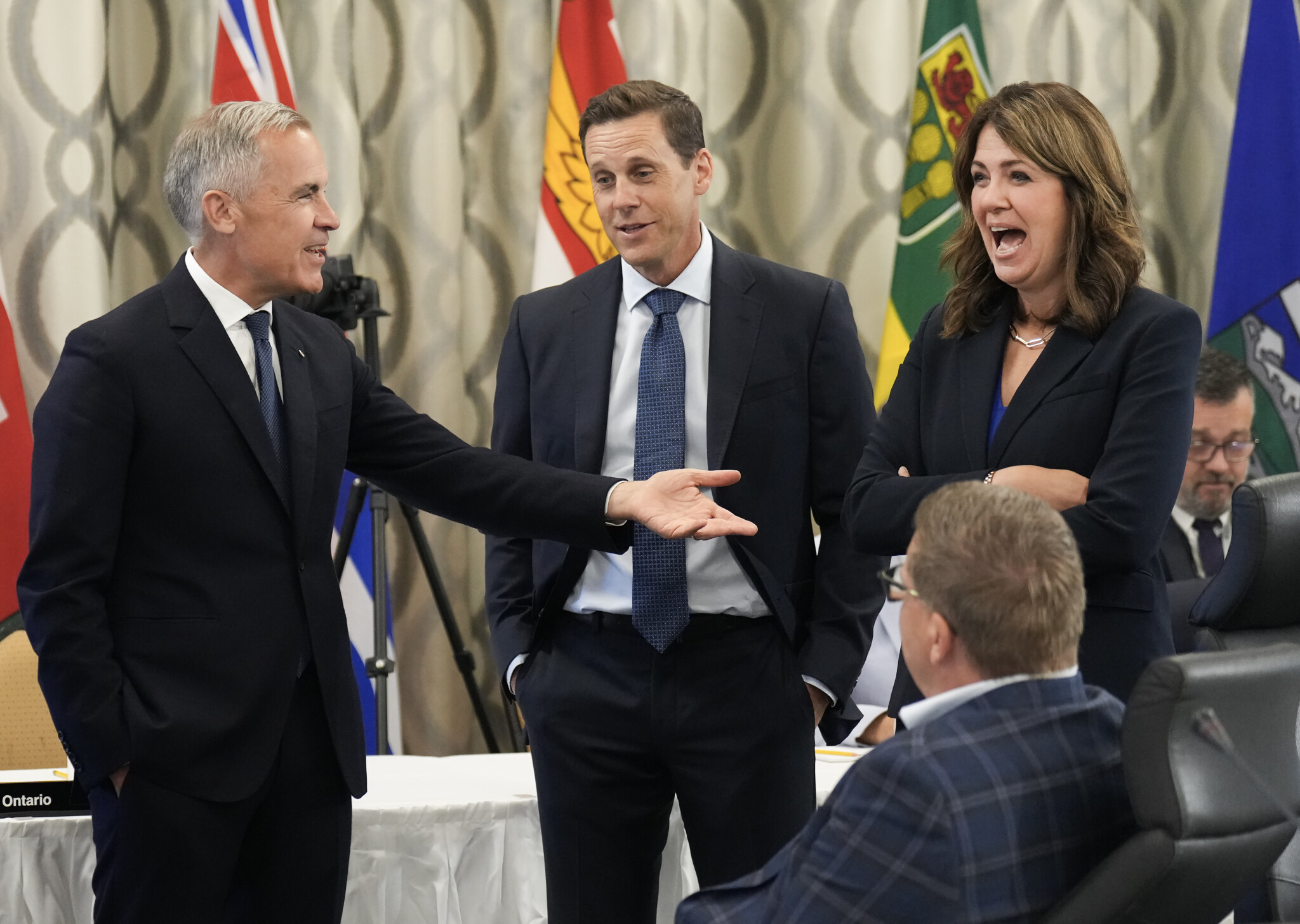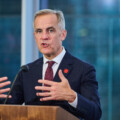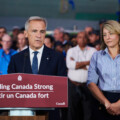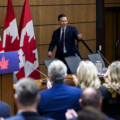Danielle Smith is not known to be a politician who plays nice with Ottawa.
Following the footsteps of Alberta premiers past, she’s never shied from picking fights with the federal government. It’s a tried and true tactic that keeps Alberta voters on side. Earlier this year, she was so uncooperative, some critics even accused her of betraying “Team Canada.”
Which is why her recent change in tone has been so striking.
More striking still is how long she’s maintained it.
When Mark Carney walked onto the Prince Rupert waterfront to announce the second wave of nation-building projects up for potential fast-track referral this week, people weren’t just listening for what was on the list, but what the prime minister had left out.
As the list of transmission corridors, mines, and LNG expansion rolled on, his speech confirmed what the media had been reporting.
No bitumen pipeline from Alberta.
That omission provided an irresistible opening for his critics. Conservative leader Pierre Poilievre pounced on the chance before the announcement even landed, comparing the Liberal government to a pub that keeps hanging up a sign promising “free beer tomorrow” day after day.
Not Smith, though.
Instead, the premier’s office issued a friendly statement.
“Alberta is supportive of all the projects reportedly included on the second list of nation-building projects,” the short and sweet statement read.
It goes on to say the province is negotiating an MOU with Ottawa aimed at scrapping or reworking a series of federal laws that it blames for “chasing away private investment” in the energy sector—and securing a pathway toward the “ultimate approval of a bitumen pipeline to Asian markets.”
Smith made a similar statement in response to last week’s budget. But with the Grey Cup just around the corner, the prospect of Carney blowing past that deadline, which the two have been hinting at for weeks, didn’t seem to make any difference.
All we know now is that some kind of agreement over the so-called “nine bad laws” is forthcoming, possibly within days or weeks.
As they say…the plot thickens.
A major detail missing from all of this may offer the biggest clue about what else is going on.
If the now-famous “grand bargain” is a two-part deal—decarbonization first, export infrastructure second—then the absence of the Pathways Plus carbon capture project from Thursday’s list suggests the first condition is also being hammered out behind closed doors.

Between what Budget 2025 spelled out, what Smith has been signalling, and what First Nations leaders have publicly said about the consultations underway (or not underway), it’s reasonable to deduce that all roads lead to the proposed 400-kilometre carbon dioxide pipeline and storage hub.
Carney was asked about it during Thursday’s scrum.
He didn’t dismiss the idea. In fact, he leaned into the same wink-wink, nudge-nudge style answer he’d given at the Canadian Club last week when asked about an oil pipeline.
“The negotiations are going well,” he said this round. “I’m personally encouraged by the progress that we’re making.”
He went on to describe how the Major Projects Office remains engaged on a carbon capture and storage project. The fall budget includes a series of tax credits Pathways could be eligible for, including the CCUS investment tax credit, which covers 50 percent of capture equipment and more than a third of transportation and storage costs.
“This is a huge opportunity for Canada to develop a huge industry,” Carney said, adding it’s all very much part of ongoing discussions with Alberta.
Ottawa has already repeatedly said, in writing, that Pathways Plus is a “transformative strategy” for the country—the kind of project that could enable low-carbon oil exports. And the Major Projects Office’s own update states that the two levels of government have formed a working group to discuss how to advance it.
So what’s the holdup?
Pathways Alliance—the group behind the $16.5 billion proposal—declined to provide comment. (The consortium of six oilsands companies has sponsored The Hub in the past.)
But there are bread crumbs. And they seem to lead to consultations with Indigenous communities.
More than half a dozen First Nations in northern Alberta have formally asked Ottawa to subject Pathways to a full federal impact assessment. Last month, Kelsey Jacko, chief of Cold Lake First Nations, wrote an editorial laying out his concerns.
He noted that the project would sit directly beneath his community.
“The project also sets the stage for building a pipeline to tidewaters in the future,” Jacko wrote, adding that how Ottawa handles it will signal whether Canada can balance industrial expansion with Treaty rights and reconciliation.
“In July, the prime minister promised to consult directly with Cold Lake First Nations and our Treaty 6 neighbours before any decision on Pathways,” Jacko continued. “Despite repeated outreach, that promise remains unfulfilled.”
He’s not alone.
Allan Adam, chief of Athabasca Chipewyan First Nation, raised similar red flags in an interview with the CBC’s West of Centre podcast over the summer.
“Nobody wants to do the proper analysis to conduct an environmental review that’s going to answer all the questions that are there,” he said in July.
When asked what would happen if the government fast-tracked Pathways under Bill C-5, Adam did not mince words. He hinted at “civil disobedience” and said the project would almost certainly be met with legal action.
However, neither chief slammed the door shut.
In fact, both offered a way forward—if governments and industry take their obligations seriously.
Jacko was explicit that members of Cold Lake First Nations are “not opposed” to development. What they want is a project that protects their land and water, respects Treaty rights, and provides fair, transparent benefits for the people being asked to shoulder the risks.
Adam said his community wants economic opportunity and a better future, but not at the expense of safety or rights.
When pressed further, he turned to revenue sharing.
“Start talking about revenue sharing instead of making bills that are going to go against us to fight in the courts,” Adam said.
Neither band responded to The Hub’s inquiries at the time of publication.
B.C. Premier David Eby loves to remind Albertans that no private proponent has stepped up for an oil pipeline to the West Coast. Alberta has now positioned itself as a kind of substitute proponent to kickstart the process. And at this point, the two main parties involved—Ottawa and Edmonton—are still hanging on that MOU, grand bargain, or what have you.
The thing about any tit-or-tat is it involves multiple moving parts. This particular deal has a few unresolved clauses—the regulatory changes required to attract investment, Pathways Plus, Indigenous onboarding, and then someone to actually build a pipeline.
And if there’s one thing the federal energy minister has been clear about, it’s that he never wants to negotiate in public.
Taking a shot at the feds has never put any Alberta premier in the doghouse with voters. So if the prime minister and premier are acting like they know something we don’t, chances are, whatever that something is must be worth their patience and political capital.
Why is Premier Smith's current approach to Ottawa different from her past tactics?
What is the main hurdle for the Pathways Plus carbon capture project?
What does the 'grand bargain' between Alberta and Ottawa likely entail?












Comments (0)